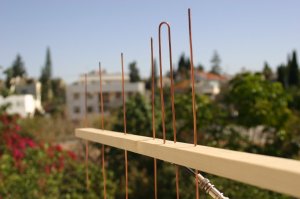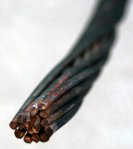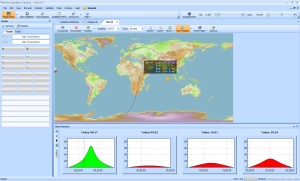Building the UHF Cheap Yagi for Satellite Communication
March 16, 2011 3 Comments
 One of the reasons to buy the FT-857D transceiver was to experiment with satellite communications. There are many antennas that are suitable for satellite communications in UHF and VHF. After investigating a bit I discovered articles on so-called cheap Yagi antennas that seemed easy to build. I started with the 435MHz Yagi, which is a little easier to build than the 144MHz version.
One of the reasons to buy the FT-857D transceiver was to experiment with satellite communications. There are many antennas that are suitable for satellite communications in UHF and VHF. After investigating a bit I discovered articles on so-called cheap Yagi antennas that seemed easy to build. I started with the 435MHz Yagi, which is a little easier to build than the 144MHz version.
The antennas were designed by Kent Britain starting in 1994. Kent’s web site contains one document with designs for the satellite bands and another with construction data for other bands. Kent suggest to build the boom from wood, which is what I did. For the elements I used stiff copper wire that I salvaged from a piece of power line that the local utility discarded when they replaced a power pole near my home. At least for the 435Mhz elements, which are about 35cm long, it is stiff enough. The boom is made of a 240cm piece of 18mm-by-36mm lumber. The 6-element Yagi I built does not use the entire 240cm length, only about 75cm. I drilled the holes for the elements with a hand drill.
At least for the 435Mhz elements, which are about 35cm long, it is stiff enough. The boom is made of a 240cm piece of 18mm-by-36mm lumber. The 6-element Yagi I built does not use the entire 240cm length, only about 75cm. I drilled the holes for the elements with a hand drill.
Three articles by Richard Crow on the AMSAT web site shows how to build satellite UHF and VHF Yagis with a boom made of a lamination of foam board. For some people they might be easier to build than the wood-boom Yagis, and they are lighter. I found that constructing the wood boom with hand tools very easy; I think that cutting and laminating foam boards would have taken me more time.
The antenna was as easy to build as Kent claims. I just built the antenna according to the measurements in his article (Crow gives the same dimensions except for the separation in the driven element, which Kent wrote to me is not critical). I then soldered the coax and tested. The antenna had low SWR without any tuning.
The antenna had low SWR without any tuning.
On the right you can see the discarded power line I used for the elements and the connection of the feed line to the driven element.
After I finished building the antenna, I tried to receive a signal from a couple of satellites, but I heard nothing. The satellites I tried to receive were operational according to the AMSAT web site (click on Sat Status), they were overhead according to the satellite tracking module of Ham Radio Deluxe, but even when the receiver was tuned to the correct frequency and the antenna aimed in the general direction of the satellite, I could not detect any signal. I did not expect this to be easy, so I was not surprised at all.
 The next morning I tried again. Again I could not detect the first satellite I tried to receive, but the second attempt was successful; I was able to hear the Morse beacon of CO-58 very clearly. I was very happy. Experiencing the Doppler shift for the first time was really interesting.
The next morning I tried again. Again I could not detect the first satellite I tried to receive, but the second attempt was successful; I was able to hear the Morse beacon of CO-58 very clearly. I was very happy. Experiencing the Doppler shift for the first time was really interesting.
[An update from March 18: I was also able to hear people communicating through the FM repeater of AO-51; very cool]
To actually communicate using satellites, I’ll also need a 144Mhz antenna. Richard Crow’s construction articles show how to mount the two Yagis side by side on a camera tripod. The configuration is the same as when two Yagis are mounted on azimuth-elevation rotators. It works on a tripod because Crow’s Yagis are very light; I am not sure that this setup will work well with wooden booms. Kent Britain’s article shows a 5-element 435MHz Yagi and a 2-element 144MHz Yagi on the same boom, one behind the other. This is more convenient, but would be a bit awkward with longer antennas. The Arrow II antenna puts the two Yagis on the same length of boom, one vertically and the other horizontally. This is more compact than putting them one behind the other, but it makes it hard to stow and transport the antenna. This is not an important concern if you keep it mounted outdoors, or if you take it apart when you stow it, but the cheap Yagis are not easy to take apart. I’ll have to ponder this issue for a while.
Satellite communication with a single transceiver also requires a band splitter; fortunately, Kent Britain’s article also shows how to build a simple band splitter; I’ll probably build it after I build the 144MHz Yagi.
That looks just like the one I made to receive the Arecibo signals last summer! I thought it worked very well. I need to pair it up with a redundant 2m Moxon to try satellites for myself, though I would need a duplexer for that too.
One UK ham on qrz.com claimed he worked FM satellites using just a 3 element 2m yagi made from steel tape measure on transmit and receive, no splitter needed. I don’t know how well that would work as a receive antenna on 70cm and I haven’t been willing to sacrifice a tape measure yet to try it.
Pingback: Finishing Up the Satellite Yagi « Eclectic Technical Experiences
Pingback: All-Mode VHF/UHF Reception with a Low-Cost TV Dongle « Eclectic Technical Experiences